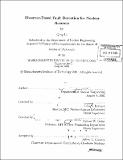| dc.contributor.advisor | John A. Bernard and Michael W. Golay. | en_US |
| dc.contributor.author | Li, Qing | en_US |
| dc.contributor.other | Massachusetts Institute of Technology. Dept. of Nuclear Engineering. | en_US |
| dc.date.accessioned | 2006-03-24T18:11:04Z | |
| dc.date.available | 2006-03-24T18:11:04Z | |
| dc.date.copyright | 2001 | en_US |
| dc.date.issued | 2001 | en_US |
| dc.identifier.uri | http://hdl.handle.net/1721.1/30005 | |
| dc.description | Thesis (Ph. D.)--Massachusetts Institute of Technology, Dept. of Nuclear Engineering, 2001. | en_US |
| dc.description | Includes bibliographical references (p. 153-156). | en_US |
| dc.description.abstract | This is a study of fault detection for nuclear reactor systems. Basic concepts are derived from fundamental theories on system observers. Different types of fault- actuator fault, sensor fault, and system dynamics fault can be detected and localized by studying the asymptotic response of an error signal constructed from the system inputs, system outputs, and observer outputs. False alarm and failure to detect a fault are two decision errors when noise is considered. The goal here is to achieve a reasonable compromise. The two types of decision errors can be characterized by their respective first hitting time of a decision threshold. This in turn is dependent on the design of the observer and the decision rule. Costs corresponding to these two types of decision error are defined by cost functions that are in turn constructed based on experience and knowledge of the system operation. A method has been developed in this research to find an optimal design of the observer, the design of a frequency-dependent output filter, and a decision rule that could achieve the desired economic goals. This technique is applied to nuclear reactor systems and simulations are carried out. The one-group linear nuclear reactor model is used in the observer. The system is modeled by a one-group linear model and by a six-group non-linear model. Results show that this fault detection method can not only detect a fault but also localize it at the same time by constructing specially targeted fault detection filters. These fault detection filters are robust against measurement noise and modeling errors. | en_US |
| dc.description.statementofresponsibility | by Qing Li. | en_US |
| dc.format.extent | 156 p. | en_US |
| dc.format.extent | 4966739 bytes | |
| dc.format.extent | 4966547 bytes | |
| dc.format.mimetype | application/pdf | |
| dc.format.mimetype | application/pdf | |
| dc.language.iso | eng | en_US |
| dc.publisher | Massachusetts Institute of Technology | en_US |
| dc.rights | M.I.T. theses are protected by copyright. They may be viewed from this source for any purpose, but reproduction or distribution in any format is prohibited without written permission. See provided URL for inquiries about permission. | en_US |
| dc.rights.uri | http://dspace.mit.edu/handle/1721.1/7582 | |
| dc.subject | Nuclear Engineering. | en_US |
| dc.title | Observer-based fault detection for nuclear reactors | en_US |
| dc.type | Thesis | en_US |
| dc.description.degree | Ph.D. | en_US |
| dc.contributor.department | Massachusetts Institute of Technology. Department of Nuclear Engineering | en_US |
| dc.contributor.department | Massachusetts Institute of Technology. Department of Nuclear Science and Engineering | |
| dc.identifier.oclc | 55011780 | en_US |
